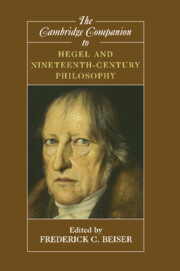Book contents
- Frontmatter
- Introduction: The Puzzling Hegel Renaissance
- 1 Hegel: A Life
- 2 Ancient Skepticism, Modern Naturalism, and Nihilism in Hegel’s Early Jena Writings
- 3 Hegel’s Phenomenology as a Systematic Fragment
- 4 The Independence and Dependence of Self-Consciousness: The Dialectic of Lord and Bondsman in Hegel's Phenomenology of Spirit
- 5 Hegel’s Logic
- 6 Hegel’s Idealism
- 7 Hegel and Hermeneutics
- 8 Hegel’s Social Philosophy
- 9 Hegel’s Philosophy of Religion
- 10 Hegel and Mysticism
- 11 Philosophizing about Nature: Hegel’s Philosophical Project
- 12 Hegel’s Criticism of Newton
- 13 The Logic of Life: Hegel’s Philosophical Defense of Teleological Explanation of Living Beings
- 14 Hegel and Aesthetics: The Practice and “Pastness” of Art
- 15 The Absence of Aesthetics in Hegel’s Aesthetics
- Bibliography
- Index
13 - The Logic of Life: Hegel’s Philosophical Defense of Teleological Explanation of Living Beings
Published online by Cambridge University Press: 28 July 2009
- Frontmatter
- Introduction: The Puzzling Hegel Renaissance
- 1 Hegel: A Life
- 2 Ancient Skepticism, Modern Naturalism, and Nihilism in Hegel’s Early Jena Writings
- 3 Hegel’s Phenomenology as a Systematic Fragment
- 4 The Independence and Dependence of Self-Consciousness: The Dialectic of Lord and Bondsman in Hegel's Phenomenology of Spirit
- 5 Hegel’s Logic
- 6 Hegel’s Idealism
- 7 Hegel and Hermeneutics
- 8 Hegel’s Social Philosophy
- 9 Hegel’s Philosophy of Religion
- 10 Hegel and Mysticism
- 11 Philosophizing about Nature: Hegel’s Philosophical Project
- 12 Hegel’s Criticism of Newton
- 13 The Logic of Life: Hegel’s Philosophical Defense of Teleological Explanation of Living Beings
- 14 Hegel and Aesthetics: The Practice and “Pastness” of Art
- 15 The Absence of Aesthetics in Hegel’s Aesthetics
- Bibliography
- Index
Summary
Hegel accords great philosophical importance to Kant's discussions of teleology and biology in the Critique of the Power of Judgment, and yet also disagrees with Kant's central conclusions there. More specifically, Kant argues for a generally skeptical view of teleological explanation of living beings; Hegel responds that Kant should instead defend such explanation - and that the defense of teleology should have led Kant to different conclusions throughout his theoretical philosophy.
To be sure, Kant's view is not entirely skeptical. Kant actually argues that we necessarily conceive of living beings in irreducibly teleological terms. But we cannot know that living beings themselves truly satisfy the implications of teleological judgment. We cannot know whether teleology truly explains anything in biological cases. And this skepticism requires Kant to carefully limit his positive claims about teleology: it is subjectively necessary we conceive of living beings in teleological terms, and this conception is legitimate when employed not as an explanation but as a heuristic aid for scientific inquiry.
Hegel's response in his Science of Logic and Encyclopedia is by no means entirely critical. Hegel frequently praises a distinction central to Kant's analysis of teleology - the distinction between “external” and “inner purposiveness” [innere Zweckmä Bigkeit]. On the one hand, there is the concept of a complex system, like a pocketwatch with many parts, which satisfies the implications of teleological judgment in virtue of the work of a separate or external intelligent designer. Here the parts of the system are means to the external ends or purposes [Zwecke] of a designer (e.g., reliable indication of the time).
- Type
- Chapter
- Information
- Publisher: Cambridge University PressPrint publication year: 2008
- 10
- Cited by



